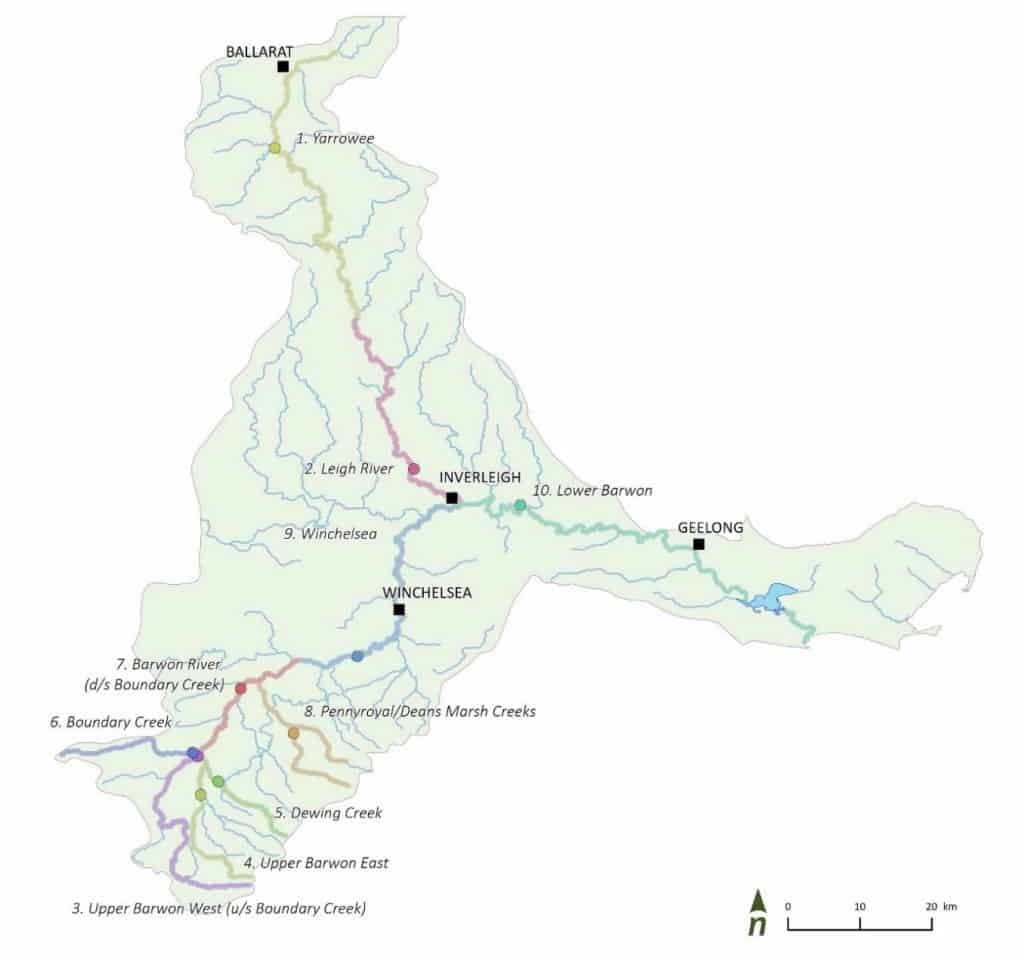The Barwon River rises in the Otway Ranges and flows through or near the townships of Forrest, Birregurra, Winchelsea, and Inverleigh, before flowing through Geelong and the Lower Barwon Wetlands to empty into the ocean at Barwon Heads.
The Leigh River, a major tributary, rises near Ballarat and joins the Barwon River at Inverleigh. Two other tributaries, Birregurra and Boundary Creeks, flow into the Barwon from the western part of the catchment.
The Moorabool River is also a major tributary of the Barwon River, flowing southward from the Central Highlands between Ballarat and Ballan and joining the Barwon River at Fyansford. The waters of the Barwon flow through Traditional Owner Country of the Eastern Maar and the Wadawurrung peoples.
The Barwon River is a major water supply for Geelong and smaller urban centres, and is also an important farm water supply for the region. The system is significantly altered via extensive farm dam storages, on-stream reservoirs and many diversion licences.
The West Barwon reservoir supplies a substantial percentage of Geelong’s Water supply, via transfers to Wurdee Buloc Reservoir. Grazing for livestock (beef, sheep and dairy) and forestry dominate the catchment, with 89% of the landscape zone dedicated to these practices, bringing significant economic benefits to the region. Sections of the Great Otway National Park and Otway Forest Park are also in the catchment.
The Upper Barwon Environmental Entitlement was established in 2018 and provides approximately 1,000 ML per year which can be released from the West Barwon Reservoir near Forrest. This is a small amount of water for a big system, but it is hoped that release of this water over summer will assist in maintaining flow and water quality. Releases can be made down both the Upper East Barwon River and the Upper West Barwon River to benefit both these reaches, but also to get water down to reaches past the confluence, towards Winchelsea.

Watering actions (or flow components) are informed by FLOWS studies which are conducted every 5-10 years. They are delivered in a priority order guided by the science and water availability. There is insufficient natural flow and environmental water to achieve all the recommended watering actions, so actions are prioritised starting with dry period low flow, then dry period freshes, with the east branch prioritised over the west branch.
Flow variability (different volumes of water throughout each release) has a positive impact on the ecosystem by aiding native fish species, providing different levels of inundation of sediments which can promote recruitment of instream vegetation and is important for the hatching of invertebrate eggs. We will continue flow variability for 2023-24 water year (financial year).
Some water, approximately 500 ML is reserved in case of drought. This water is only released in small bursts during a drought to prevent loss of aquatic animals, such as fish and platypus.
It should also be noted that complementary actions such as removal of choking weeds and fish barriers are needed, together with riparian and channel restoration, to gain maximum benefit from the delivery of environmental water.
| Priority | Flow Component | Flow Objective |
| 1 | East branch: Dry Period (Dec-May) Low Flow (0.5-5 ML/d) | Provide water in pools for habitat and to maintain food sources for fish and platypus. Provide adequate depth of permanent water in channel, with natural seasonal drawdown to promote recruitment of in-stream vegetation and to limit encroachment of terrestrial vegetation. Maintain a shallow water table with low salinity groundwater throughout the year. |
| 2 | East branch: Dry Period Freshes (Dec-May modified from 35 ML/day to 6-9ML/d for 2 days x 2) | These freshes provide flushes that assist in maintaining adequate water quality and the opportunities for migration of fish and other fauna. Without these freshes, there’s the potential for regional extinction and many species will not be able to move to new habitats and reproduce. Flow constrictions in the Upper Barwon branch will only allow delivery of less than 9ML/d to prevent localised flooding. Peak fresh volumes will be modified based on delivery experience gained from previous water years and ‘real time’ local knowledge around constriction management. |
| 3 | West branch: Dry Period Low Flow (Dec-May, 3 to 30ML/d, as water availability permits) | As mentioned above, low flows are required for the survival of high value species, to provide essential habitat for aquatic fauna and to provide moisture to instream and emergent macrophyte vegetation. While the next priority in the FLOWS study is wet period freshes, such freshes cannot be delivered down the Upper Barwon east branch due to flow constrictions. It has therefore been decided that delivering dry period low flow down the Upper Barwon west branch should be the next priority. This can be done at the recommended rate of up to 30ML/d, but because of water availability is likely to be delivered at a much lower rate. |
| 4 | East branch: Wet Period Low Flow (Jun-Nov modified from 10ML/day to 1-9ML/d or natural) | These flows play an important role in channel shape and form over long time scales and failure to provide these flows over long periods of time may result in reduction of available habitat due to deposition of material in pools and other changes in channel form. |
| 5 | West branch: Dry Period Fresh (Dec-May modified from 100ML/d to 20-30ML/d for 6 days x 5) | As above, after all the flow components that can be physically delivered down the Upper Barwon east have been achieved, the next priority is to target a dry period fresh down the Upper Barwon west branch following dry period low flow has been achieved. |
| 6 | West branch: Wet Period Low Flow (Jun-Nov modified from 100 ML/d to 20-30ML/day) | As mentioned above, these flows play an important role in channel shape and form over long time scales and failure to provide these flows over long periods of time may result in reduction of available habitat due to deposition of material in pools and other changes in channel form. While the next flow component priority after dry period freshes is wet period freshes, they are undeliverable at anywhere near the recommended volume, with the current restrictions. Wet period low flow is therefore the next priority and can be achieved in a modified form if the water was available. |
The water year starts on July 1 (like the financial year). The timing for a lower priority flow component may come up before a higher priority flow component, so planning delivery requires careful consideration of available water and the long term weather forecast.
Download the one-off comms letter explaining a bit about this summer’s environmental releases. The letter goes into detail regarding the difference between passing flows and environmental releases, environmental releases for this summer, what to do if you notice flooding and some links to some interesting tools online.
This document has been designed to cover Water for the Environment in the Upper Barwon. It conveys what environmental water is for, why it is important and how delivery is managed.
The Upper Barwon Surface Water Advisory Group (UBSWAG) was established by the Corangamite Catchment Management Authority (CCMA) to provide feedback on surface water management planning in the Upper Barwon River to achieve environmental outcomes.

64 Dennis Street, Colac VIC 3250
PO Box 159, Colac, VIC 3250
Hours: 8:30am – 5pm, Monday to Friday
T: 1800 002 262
E: info@ccma.vic.gov.au
BARWON WATER OFFICES
Hours: 8:30am – 5pm, Monday to Friday
All mail must be sent via our Colac office
PO Box 159, Colac, VIC 3250
T: 1800 002 262
E: info@ccma.vic.gov.au
 Close
Close